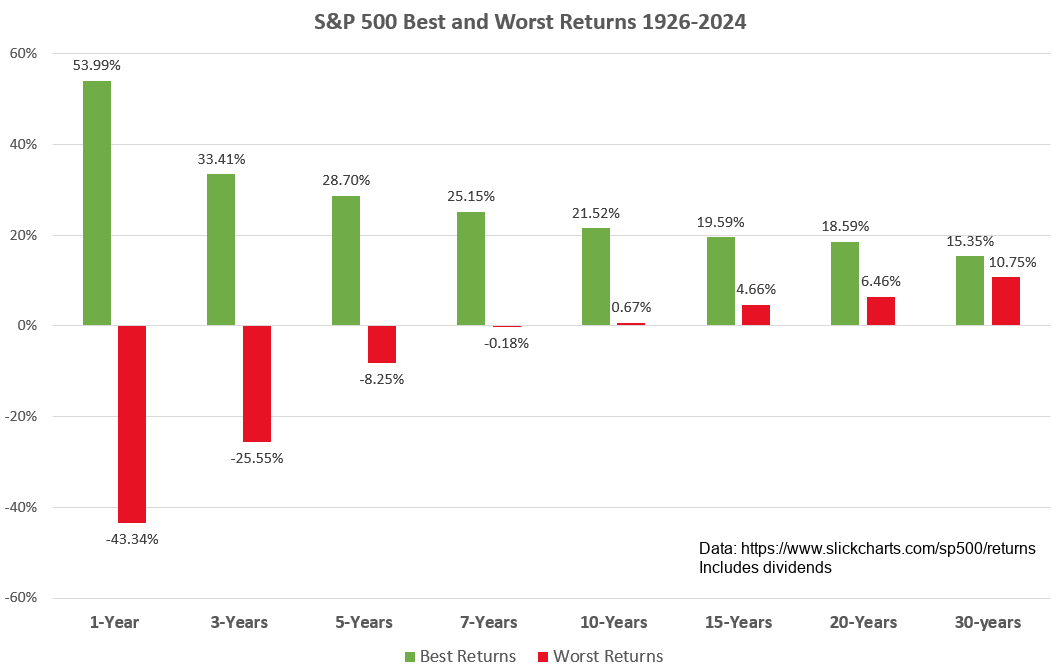Invest in “Uncertain” markets

The Pittsburgh Steelers won four Super Bowls in the 1970s, a legendary run.
My uncle was a stubborn steelhead from the 1970s and 1980s.
He has a season ticket, he made it up Tiecheng Beer “kegerator” in his basement and bet on the results of the Olympics.
Sports betting is common today. But back in the 1970s, in Pennsylvania, it was illegal. You will interact with some dark books for sports betting.
After the fourth championship in the 1979 season, “Mean” Joe Green won the Thumb One title in the 1980 season.
But they missed the profits, and it took another 25 years for the Steelers to finally make a “Thumb One”.
Sometime during the drought, I asked my uncle about his bets on the glorious era of the 1970s and the dog era of Mark Malone and Bubby Brister, and he said:
I never bet Steel man. But sometimes, I don’t make bets.
Now, replace the word market For Steeler.
It is wise to never bet on the market. But when you sometimes don’t invest, it’s expensive.
Investing is not gambling
Long-term stock market investment is not gambling.
However, the stock market can both invest and gambling.
gamble The market is easier than ever. Just whip your phone and click.
- Win bets by bringing company revenue.
- Bet or oppose any “team” in the market.
- Complex investments (Parlays) through options or leverage.
invest It’s easier on the market than ever before.
- Invest in the “market” by owning market ETFs (such as VOO or spy) or mutual funds.
- Invest in a business, buy individual stocks and hold them for a long time.
However, because the market is always an “uncertain” position in the short term, more frequent investment decisions reduce your chances of success.
The best way to improve returns is to expand your investment and keep your hands on your own.
Long-term market returns are more certain
I first encountered the best and worst return chart of the S&P 500 index Wealth common sense Ben Carlson Blog.
I often think about this chart.
It shows the best returns for every period dating back to 1926.
I recreated the chart using S&P 500 data from the SLICK chart, which included dividends.
The one-year column is the best and worst year-on-year rewards from 1926 to 2024. Three-year and longer rolling averages.

The purpose of this chart is to show that the returns become less certain as the time frame increases.
The rewards of a year swing wildly. But long-term returns are more stable.
Some gains. In the past 99 years:
- Stocks lose no currency during any 10-year period (before inflation) and almost all seven-year periods.
- The worst 20-year investment period for the S&P 500 rose by 6.46% (1928-1948).
- The best 20-year return period is an increase of 18.59% (1979-1999).
- this Worst performing The 30-year period is 10.75% (1955-1985). It never dropped below 10% in 99 years!
- The worst-performing 15-year term was 4.66% (1929-1943), but only 6.09% since 1975.
As you expand your investment horizons to over 30 years, if you invest in a market index and can’t do anything, your return will be greater than 10%.
However, in the short term, the market is always uncertain.
Always investing
Investors lose more money in investors who are preparing for corrections or expecting corrections, rather than in corrections themselves. – Peter Lynch, Worth magazine 1995.
Our best defense against short-term volatility is the diversified portfolio of U.S. stocks, international stocks and bonds.
If your portfolio is aligned with your investment scope and goals, there is no need to react to the market.
When the market declines, media and influencers quickly call it a crash or uncertain.
But market fluctuations are normal. What is abnormal is that the market continues to rise without occasional pullbacks.
Although you would love to stop, always invest new funds into your portfolio through your employer’s 401(k) contribution or income surplus investment to invest it in your IRA or taxable account.
Automate your investments by dollar cost to average your monthly income surplus to avoid behavioral errors.
When the market drops, you buy it at a discounted price. If the market is higher, you will buy fewer stocks.
Don’t sell when you think the market is too hot. you do not know.
But we should still prepare for the painful markets, only at the moment when they become painful.
Prepare for the next crisis when time is good
What we see in the stock market in early 2025 is not uncertainty. The market behavior is normal.
Economic uncertainty? Yes.
The market is doing things to figure out how domestic policy and trade disruptions will affect company revenue.
Response is the job of the market, not yours.
When the market makes you uncomfortableWhat OCUS can control: expenses, tax savings, savings rates, good financial habits and investment behaviors.
However, if you are considering a portfolio or financial modification of the market, it is too late when the market is down like in Q1 2025.
When is the time to prepare for uncertainty good?
Your preparation should be consistent with your age, risk tolerance and investment goals.
When the stock market reaches new highs (such as 2023 and 2024):
- Make sure your assets are allocated appropriately.
- Rebalance once a year for proper alignment.
- Avoid risk investments that are vulnerable to economic downturns.
- There is enough cash on hand for expenditure and provides a buffer of unexpected cash.
Thankfully, long-term success in investing in the stock market is the same as betting on American football games.
If you invest successfully in the U.S. stock market, the possibility of long-term investment is high.
My uncle Jim wisely didn’t bet on the Steelers often when franchise faced challenges in the 1980s.
But, it turns out that investments over and over are opportunities to enhance long-term wealth.
Feature images generated by dall-e.
Favorite tools and investment services (sponsored):
Boldin – Insufficient spreadsheets. Build financial confidence. (Review)
Morningstar Investors – Trusted Funds and ETF Research + Portfolio Tracking. Free 7-day trial.
Determine dividends – Free download of research dividend stocks (comments):
Fundraising – Simple real estate and venture investments are only $10. (Review)






